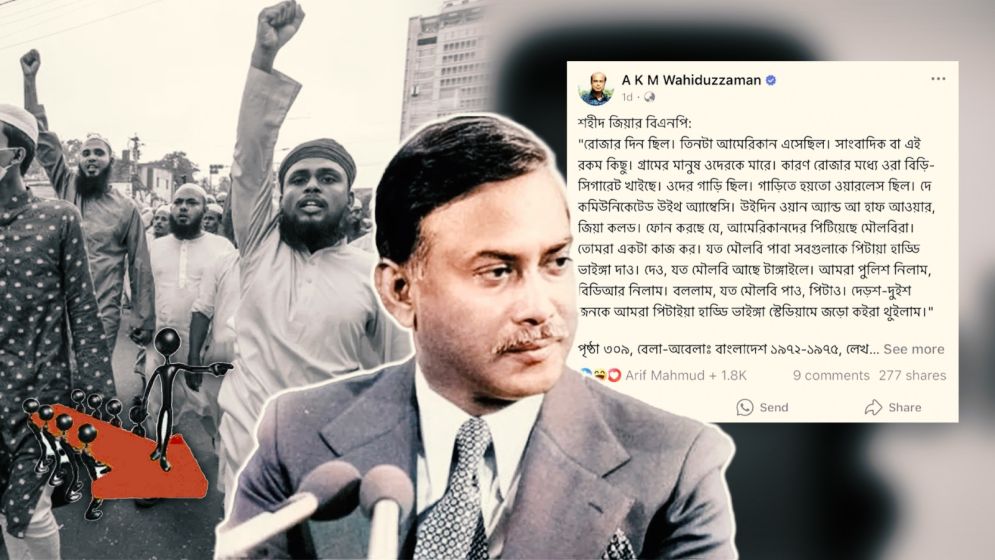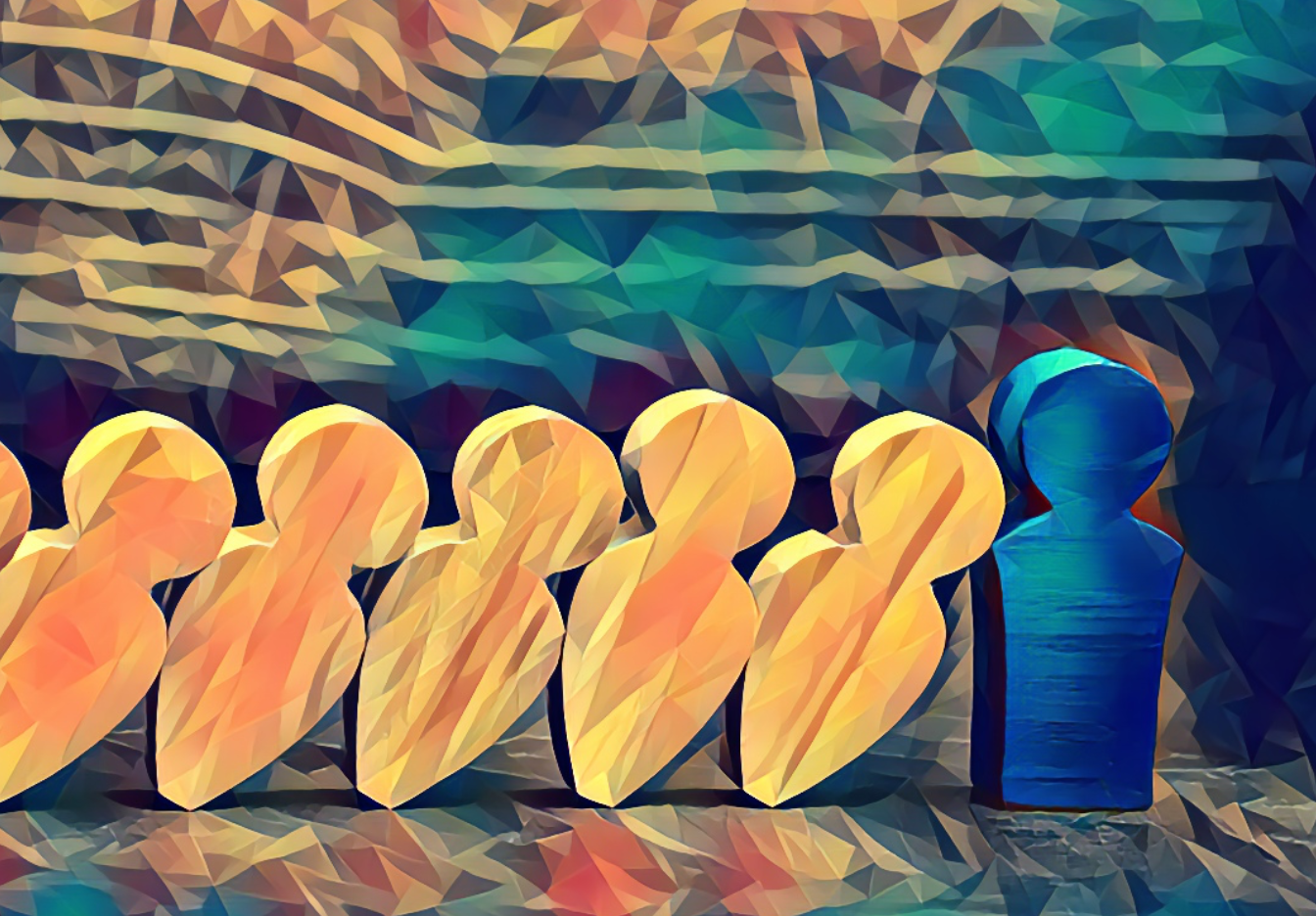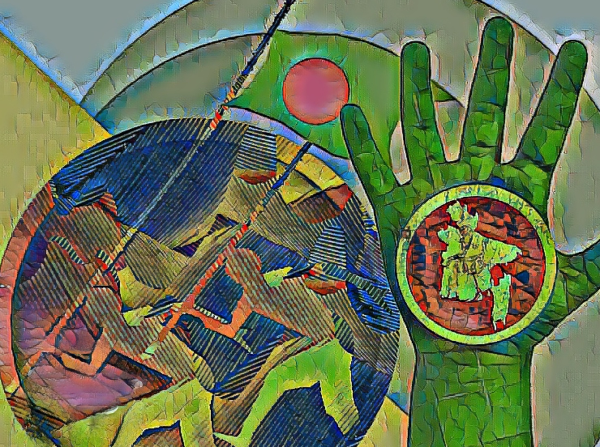Wahiduzzaman’s post, Shaheed Zia, and the rising controversy of “Tauhidi Janata”

The recent Facebook post by A K M Wahiduzzaman, a researcher and member of the Bangladesh Nationalist Party (BNP), has ignited a firestorm of debate and controversy online.
Quoting from writer Mohiuddin Ahmad's book, Wahiduzzaman aimed to shed light on the hardline methods of Ziaur Rahman, Bangladesh’s martyred president, in suppressing protests during the early days of his rule.
The passage he shared, which details a crackdown on religious clerics following an incident with American journalists, has sparked widespread discussion—particularly given its portrayal of Zia’s use of state violence to quell dissent.
In the excerpt Wahiduzzaman shared from Bela-Obela: Bangladesh 1972-1975 by Mohiuddin Ahmad, the following account is given:
“It was a day of fasting (Ramadan). Three Americans came. Journalists or something like that. The villagers beat them because they were smoking bidis (a type of cigarette) during the fast. They had a car. The car probably had a wireless (radio). They communicated with the embassy. Within an hour and a half, Zia called. He said that the Americans had been beaten by the maulavis (Muslim clerics). You do one thing. Beat up all the maulavis you can find and break their bones. Go, as many maulavis as there are in Tangail. We took the police, BDR (Bangladesh Rifles). We told them, beat up any maulavi you find. We beat up one and a half to two hundred people, broke their bones, and gathered them in the stadium.” (Page 309, Bela-Obela: Bangladesh 1972-1975, Author- Mohiuddin Ahmed)
This passage, a graphic depiction of state-sanctioned violence, has led to intense debate, with many questioning the legacy of Zia’s tactics.
At the heart of the controversy however is the role of the "Tauhidi Janata," a group of religiously motivated activists in Bangladesh, and their relationship with the Awami League.
These groups—often supportive of the Awami League—have been more subdued under its rule, but they emerge as vocal challengers when the party is in a weakened state.
During Sheikh Mujib's time, they were kept under pressure – but they didn't utter a single word. The leftist parties of that time protested against Mujib's rule. The Tauhidi Janata were nowhere to be seen – they were living in their holes like the Muslim League.
As soon as Mujib fell – all the Tauhidi Janata came out of their holes and started creating all kinds of nuisances.
On March 26, 1976 – defying martial law, a huge public meeting of the Tauhidi Janata was held in Dhaka – the excuse was the Siratunnabi conference – the main speaker? Air Vice Marshal (Retired) Muhammad Ghulam Tawab.
They openly and strongly demanded – Bangladesh should be declared an Islamic Republic.

The need for inflicting “violence”
Ziaur Rahman's new government was under a lot of pressure at that time.
Lt Col Sayed Farooq-Ur-Rahman, Lt Col Khandaker Abdur Rashid and Tawab were trying to raise the flag of Islamic revolution, while Lt Col Abu Taher's leftist followers were also organizing – various conspiracies were going on inside the military.
The Awami League, which was in exile in India, was also not silent – a small part of it, led by Kader Siddiqui, along with an Indian agency, was plotting to assassinate Zia.
The first significant challenge to Zia’s authority came from the Islamists themselves. Within weeks of the Siratunnabi Mahfil on March 26, a rebellion erupted at the Bogura Cantonment.
Led by Lt Col Farooq’s Bengal Lancers, who were backed by a fleet of tanks, the insurgents seized control of the cantonment.
This marked a critical turning point in Zia’s leadership, as both Islamist and leftist factions began to present serious threats to his regime.
In the early days of Zia’s rule, the political climate was exceptionally volatile, with mounting internal pressures, particularly from military factions.
Zia faced a delicate situation—sending a large brigade to Bogura was not feasible, as it would leave the capital, Dhaka, exposed.
Instead, he made the strategic decision to deploy Brigadier (retd) Hannan Shah, the commander of a garrison brigade in North Bengal, to address the rebellion.
What followed was a historic standoff—two brigades of the Bangladesh Army facing off for the first time in the country’s independent history.
The conflict, which pitted Hannan Shah’s disciplined forces against the fervent, Islamic zeal of the rebellious lancers, resulted in a decisive victory for the government forces.
The lancers, inspired by the Tauhidi ideology, were defeated, and the century-old brigade was disbanded for good. Zia’s hold on power was solidified, and the sovereignty of the nation preserved.

Tauhidi Janata and the lack of
tolerance
For over three decades, the Tauhidi movement—associated with Islamic fundamentalism—lay dormant during the rule of the Awami League and later under General Hussain Mohammad Ershad’s regime.
These so-called “Tauhidi” groups were largely pacified, remaining on the sidelines during numerous movements against Ershad’s rule.
But when the BNP rose to power, the Tauhidis returned to the political scene with a vengeance, escalating their actions through bombings, grenade attacks, and the targeted assassinations of bloggers and publishers.
The most recent era under the Awami League has seen a disturbing rise in their activities once again.
The events surrounding the Shapla Chattar massacre are a testament to the growing conflict, with the Tauhidi leadership, including figures like Ahmed Shafi, openly humiliated by the government.
During this time, leaders such as Mufti Amini and Maolana Mamunul Haque were beaten, imprisoned, and publicly debased.
Now my question is where were the Tauhidis during this period of political turmoil? What was their response when their leadership was compromised? For years, they were conspicuously absent.
Now, with the Awami League gone from the political scene agian, the “Tauhidi Jonota” has once again begun to stir unrest.
From slaughtering cows to attacking public figures and even disrupting cultural events, their actions are once again making headlines. The question must be asked: Where were these groups in the last 18 years, when the government was firmly in control?
As someone who believes in democracy and equal rights, I am left wondering whether these groups can truly grasp the responsibility that comes with living in a democratic society.
Can they exercise the self-restraint necessary for democratic coexistence, or is their vision limited to autocratic models of governance—such as the regimes of Hasina, Sisi, Bashar al-Assad, Erdogan, or the Saudi monarchy?
The Tauhidi Janata's compatibility with liberal democracy is not just a theoretical question; it is a fundamental issue for the future stability of the country.
—
Rumi Ahmed is a Texas-based Physician and writer

